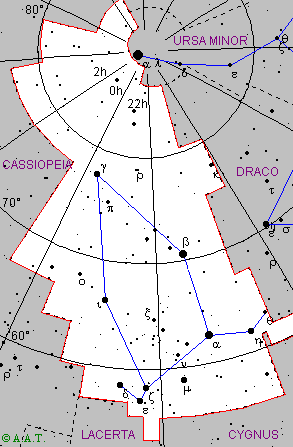 |
 |
| English name | Cepheus | ||||
|---|---|---|---|---|---|
| Major stars | alpha Cephei | Alderamin | magn. 2,6 | RA: 21h 18m 34.73s | Dec: +62° 35' 07.9" |
| beta Cephei | Alfirk | magn. 3,3 | RA: 21h 28m 39.62s | Dec: +70° 33' 38.6" | |
| gamma Cephei | Errai | magn. 3,4 | RA: 23h 39m 20.91s | Dec: +77° 37' 56.2" | |
| Description | Cepheus is a circumpolar constellation and is situated among Cassiopeia, Ursa Minor, Draco and Cygnus; its shape remembers a lengthened irregular pentagon. The most famous star is delta Cephei, a double star easily resolvable with a small telescope; the greatest component is a yellow supergiant which regularly varies with a period of around 5 days and 9 hours. The variability of this star was discovered in 1784 by the English amateur astronomer John Goodrike, who got sick of pneumonia during his observations and died when he was only twenty-one years old. Delta Cephei is the prototype of the class of variable stars called cepheids: these stars have a superficial temperature similar to that of the Sun (6.000°K), but they are rather big and therefore very bright. The peculiar characteristic of the cepheids consists in this: there is a direct relationship between their brightness and the period of variability; using this relationship, therefore, you can deduce the absolute brightness of a certain cepheid. And comparing absolute brightness to apparent brightness, you can calculate its distance. So the cepheids are very useful to esteem, for instance, the distance that separates us from a galaxy. Other interesting stars are xi Cephei (near the center of the pentagon), a double whose component rotate round each other with a 4000-year period, and my Cephei (in the southern part of the constellation), one of the most vivaciously colored stars of the sky, so that William Herschel nicknamed it "Garnet star". |
||||
| Mythology and history | Cepheus was king of Ioppa, an indeterminable place, perhaps in Palestine, perhaps in Ethiopia. He married Cassiopeia and was father of Andromeda. | ||||
 Torna alla pagina delle costellazioni.
Torna alla pagina delle costellazioni.